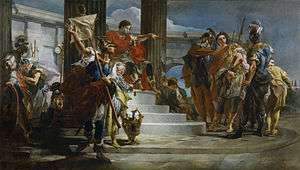Scipio Africanus Freeing Massiva (painting)
 | |
| Artist | Giovanni Battista Tiepolo |
|---|---|
| Year | between 1719 and 1721 |
| Medium | Oil on canvas |
| Dimensions | 279.4 cm × 487.6 cm (110.0 in × 192.0 in) |
| Location | The Walters Art Museum, Baltimore |
Scipio Africanus Freeing Massiva is a painting depicting a scene from ancient Roman history by the Venetian artist Giovanni Battista Tiepolo.
History
In 18th Century Venice, Giovanni Battista Tiepolo was known for his monumental wall and ceiling paintings for palaces of the city's wealthy patrons. Scipio Africanus Freeing Massiva is recognized as a pivotal piece in understanding his mastery of this genre. The painting depicts Scipio Africanus freeing Massiva, the nephew of Massinissa, chieftain of eastern Numidia. This moment in history is described by the Roman historian Livy in his chronicle of Rome's struggles with Carthage. In 209 BC, at the age of twenty-six, Scipio campaigned against the Carthaginian general Hasdrubal (brother of Hannibal) in present-day Spain. At the Battle of Baecula, Scipio defeated the Carthaginians and captured their Iberian and North African allies. The Iberians were freed but the Africans were ordered to be sold. One of the Africans is brought before Scipio and identified as Massiva, a boy of royal blood. Even though Massiva's uncle, Massinissa, is an ally of Carthage, Scipio orders the boy to be released and returned to his uncle with gifts. This act led to Massinissa allying with Scipio when his forces landed in Africa in 204 BC.[1]
The original placement of the painting is unknown but it might have been one of the paintings for Giovanni Corner, whose family claimed descent from Scipio. The surface paint suffered damage but thorough treatment in 1996 restored the impression of bravura brushwork.[1]
Composition
Scipio Africanus Freeing Massiva depicts Scipio chastising the boy for disobeying his uncles orders to remain out of the battle and Massiva is seen turning away in humiliation. The details of the painting show Scipio sitting in gilded armor on an elevated seat, surrounded by what can be identified as Roman architectural features. The representation of the Roman state is confirmed by the standard being held by one of the soldiers bearing the abbreviation S.P.Q.R. (Senate and People of Rome). Massiva shown in gilded armor and manacles is presented as a European, which was conventional practice during the 18th century even though Tiepolo would have had the opportunity to study Africans in Venice. In contrast, the African boy to the left of the painting, identified as a servant of Scipio's due to his conversation with the soldiers, is depicted accurately.[1]
Off the Wall
Currently, Scipio Africanus Freeing Massiva is being featured in Off the Wall, an open-air exhibition on the streets of Baltimore, Maryland. A reproduction of the painting, the original is part of The Walters Art Museum collection, will be on display at the Clarence M. Mitchell, Jr. Courthouse.[2] The National Gallery in London began the concept of bringing art out of doors in 2007 and the Detroit Institute of Art introduced the concept in the U.S.. The Off the Wall reproductions of the Walters' paintings are done on weather-resistant vinyl and include a description of the painting and a QR code for smart phones.[3]
Further reading
- Christiansen, K, ed. (1996). Giambattista Tiepolo, 1696-1770. New York: The Metropolitan Museum of Art. (see index)